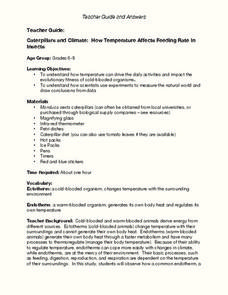Curated OER
The Effect of Temperature on Cricket Chirping
Students examine the effect of temperature on how often crickets chirp. In groups, they complete the experiment and answer lab discussion questions. They create a graph of temperatures and the amount of chirps and discuss the results.
Curated OER
Exploring Literature and Weather through Chirps
Students explore and experience information about temperature changes by using crickets' chirps to calculate the temperature. The data is applied to formula and the temperatures are calculated.
Curated OER
Exploring Literature And Weather Through Chirps
Students explore using crickets' chirps to calculate temperature. They read "Cricket in Times Square" and "The Quiet Cricket," read and discuss a Cricket eBook, develop a formula and calculate temperature using cricket chirps, and graph...
Curated OER
Crickets on the Hearth
Students investigate how crickets behave in cold temperatures. In this life science lesson, students explain the beneficial and harmful effect of pests. They research ways to properly manage them.
Curated OER
Anthropods and Echinoderms
Students examine the attributes of crickets. In this arthropods instructional activity, students observe crickets and sketch and label their parts. Students respond to questions regarding their observations.
Curated OER
Crickets Guided Discovery
Sixth graders investigate insect anatomy by analyzing a live cricket. In this insect science lesson, 6th graders discuss their knowledge of insects and describe their characteristics from memory. Students observe live crickets in class...
Curated OER
Key Problem 1
Learners find relationships between two variables. They use given data in an Excel worksheet to examine the pitch of a cricket chirp and the approximate temperature. Student determine if the recorded pitch of a cricket can actually...
Curated OER
Living Thermometer
Students count the number of times a cricket chirps in a sixty-second span and subtract 40, divide by 4 and add 50. They compare the answer to the degrees in Fahrenheit.
Curated OER
Algebra II: Crickets-Nature's Thermometer
Students translate functional relationships into equations to answer questions. Students answer questions using different representations of the relationships: function rules, graphs of the function, tables of values, and equations and...
Curated OER
Caterpillars and Climate: How Temperature Affects Feeding Rate In Insects
Do you eat more when you are hot or when you are cold? Young scientists observe the eating pace of two caterpillars at different temperatures. The differences in endotherm and ecotherm animals' ability to adjust to temperature change...
Curated OER
Linear Regression (and Best Fit)
Young scholars explore notions of relationships between two variables. They use discussion, games, worksheets, spreadsheets to consider relationships such as: height vs. shoe size, cricket chirping vs. temperature.
Curated OER
Graphing Linear Equations with Two Variables
Can your class solve linear equations in two variables? They will be able to after they engage in this instructional activity. Individuals graph linear equations in two variables using slope and intercept and identifying the relationship...
Curated OER
Chasing El Niño
Students view a video clip about the effects of El Nino. They work together to develop a question about weather folklore. They participate in an experiment that tests their hypothesis.
Curated OER
The Insect World
Students investigate how insects communicate since they cannot use their mouths for producing sound like humans can. In small groups, they devise a way to make an insect-like sound using body parts other than their mouths or vocal...
Curated OER
Weather Myths
Fourth graders examine myths that are based on weather phenomenon. They write, illustrate and present an original weather myth.
















